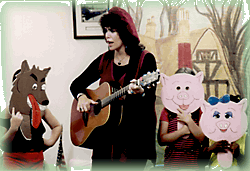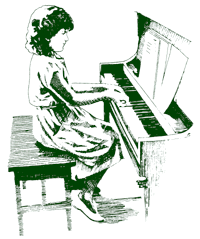 |
|
|||
Objectives Students will be able to:
Materials Copies of the lyrics of The Delaware Run and A Schooner from Delaware Bay. Optional: Copy of cassette or CD containing the songs available from Valerie Vaughn or other artists. Down Jersey Folklife Center Archive at Wheaton Village has over 300 audiotapes, mostly by New Jersey musicians. (609) 825-6800, ext. 2787 Making Connections The film Down Jersey captures both the people and the places that make the region unique. One of the most encompassing and descriptive means of relating feelings of sense of place is through the spontaneous creation of songs, stories and rhymes. While this activity focuses on the songs that Valerie Vaughn recently wrote and recorded for the Bayshore Discovery Project, the region is rich with examples of such meaningful, personal expression. Any of the topics and themes presented in the film Down Jersey and described in the Blue Book –– Historic Themes and Resources within the New Jersey Coastal Heritage Trail Route, US Department of the Interior, National Park Service (included with this packet) could be used as material for songs and stories. Background “The song are in the fishermen, not in the boats” Robert Ames, a menhaden fisherman and shanty singer from Port Norris, from an interview: Mary Hufford and Rita Moonsammy with Robert Ames, Port Norris, February 19, 1983. Excerpts from Recitation and Song (pages 59–62) One Space, Many Places —Folklife and Land Use in New Jersey’s Pinelands National Reserve, by Mary Hufford, American Folklife Center, Library of Congress, Washington, 1986 Folklife expressions survive because they are applicable. One of the oldest traditional applications for folklife expressions has been pedagogical. Folklife expressions thus perform an important function in recycling the knowledge and values of past generations. They tie past, present, and future together. Other original compositions convey images of an attitude toward places… … In contrast we have songs about the workplace. The work shanties that menhaden fishermen in Port Norris sang into the 1950s exemplify the use of a characteristically Afro-American musical form, the call-and-response pattern, to synchronize the movements of the men, fish, boats and tides when hauling menhaden (Brevoortia tyrannus, locally called “bunkers”). For the most part, the introduction of mechanized purse seines and hydraulic pumps silenced the shanties of the Black fishermen who still live in Port Norris. Until the mid-1950s, most bunkers were hauled out of the bay by men in striker boats. The work was brutally hard, for menhaden swim in densely packed schools, and a single haul could weigh several tons. … They synchronized their pulling so that all would be pulling together with their fingers moving simultaneously through three different leases in the net, the “bunting,” the “webbing,” and the “twine.” It was easy to spot a menhaden fisherman, according to Joe Gibbs of Port Norris, for the skin was split to the bone on his finger joints … Menhaden fishermen had to work quickly to “harden” the net before the fish were smothered or crushed, because if the fish stopped jumping, their dead weight was impossible to raise. Thus, the rise and fall of the tide worked its way into many rhythms of the shanties. Robert Ames of Port Norris recalled: “There’s no way in the world that thirty-two men can raise eighty ton of fish, unless they do it in a way that the sea helps them. You know what they say? When you’re down there holdin’ on, they say, ‘hold on, boys,’ say, ‘wait a minute,’ say, ‘the sea’ll give it to you.’ After awhile, she’ll go down on a swell. She’ll lighten up.” (February 19, 1983) The shanties gave the men the power to lift tons of fish, according to Ames, and a good shanty “blower” was worth his weight on any striker boat. He had to be experienced and therefore older. Said Ames: “You know what a shanty man is? A shanty man is just someone on the boat that’s old and knows how to make rhythms for you — and make you feel good and make the work easier. He don’t have to be no captain, he don’t have to be no mate. Just somebody with a lot of experience that likes to sing.” (February 19, 1983) … Similarly, Black workers in the oyster shucking houses relied on their gospel music for relief in otherwise difficult circumstances. Like other migrant workers in the region, they have little control over the land and its resources or their station on it. They are not celebrating their work, but they are enhancing their environment. It is no coincidence that the songs are generally the same as the hymns that Black congregations sing in church on Sunday throughout the region, hymns that speak of a better time in the world to come. The songs brought the workers together and helped to make their work more synchronized and lightened the burden. Singing the songs helped develop a communal relationship among the workers, and probably made the day go faster –– or at least seemed to. Valerie Vaughn — Singer, Songwriter and “Talespinner” Commentary provided by Terry O’Leary, Barnegat Bay Decoy and Baymen’s Museum Valerie Vaughn is a multi-talented musical educator from Tuckerton, New Jersey. She specializes in writing and singing tunes with South Jersey themes covering important environmental issues as well as historical sagas of people and places from the Jersey shore and pines. Performing interactive programs for children, Valerie brings to life through song: Coastal Heritage, Pirate Lore, Familiar Fairytales, Tales of the West, and, most recently, songs about the Delaware Bay and the AJ Meerwald. Her renowned “Talespinner” program for young listeners evolved after years of experience as a musician and school counselor. Providing education through music and interactive programs, Valerie’s message of protecting the environment and preserving history reaches audiences of all ages. Valerie covers a wide variety of musical styles including folk, country, blues, traditional Irish, and musical story telling. She is available for school assembly programs and public appearances, and her recordings are available for purchase. Procedure Warm Up
Wrap Up Assessment Student participation in the song writing and group discussions. Extensions Students’ songs could be assembled into a booklet and/or actually recorded. There are many high schools that have this capability in their in-house studios. Please download the PDF for the complete Lesson Plan.
Passing it on –– Folk Artists and Education in Cumberland County, New Jersey, by Rita Zorn Moonsammy, pages 38 - 48, Joseph Gibbs, African-American Gospel Singer Call Larry Sarner, NJDEP, Marine Educational Specialist at (609) 748-2031 and ask for his list of environmental singer/song writers. Down Jersey Folklife Center at Wheaton Village has an extensive collection of audiotapes and other resources related to traditional occupations from the region. Definitely worth a call: (609) 825-6800 ext. 2787 |
|||

 hardships. Many songs immortalize traditional occupations related to life within the Down Jersey region. Virtually all of the topics and themes presented both in the film Down Jersey and in this packet lend themselves to this activity.
hardships. Many songs immortalize traditional occupations related to life within the Down Jersey region. Virtually all of the topics and themes presented both in the film Down Jersey and in this packet lend themselves to this activity. The Activity
The Activity